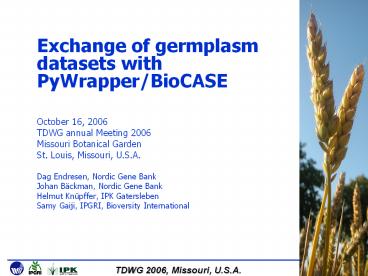Exchange of germplasm datasets with PyWrapper/BioCASE - PowerPoint PPT Presentation
1 / 20
Title:
Exchange of germplasm datasets with PyWrapper/BioCASE
Description:
Dag Endresen, Nordic Gene Bank. Johan B ckman, Nordic Gene Bank. Helmut Kn pffer, IPK Gatersleben ... Exchange of germplasm datasets with PyWrapper/BioCASE, ... – PowerPoint PPT presentation
Number of Views:36
Avg rating:3.0/5.0
Title: Exchange of germplasm datasets with PyWrapper/BioCASE
1
- Exchange of germplasm datasets with
PyWrapper/BioCASE - October 16, 2006
- TDWG annual Meeting 2006
- Missouri Botanical Garden
- St. Louis, Missouri, U.S.A.
- Dag Endresen, Nordic Gene Bank
- Johan Bäckman, Nordic Gene Bank
- Helmut Knüpffer, IPK Gatersleben
- Samy Gaiji, IPGRI, Bioversity International
2
TOPICS
- Genetic resources
- Data standards
- Data exchange
- Information network
- Outlook
3
Germplasm data, seed genebanks
- Germplasm genebanks are biodiversity collections.
- Collection level data
- Metadata about genebank institutes and the
germplasm collections they hold. - Unit level data
- The unit level data for germplasm collections
are the accessions. Genebank accessions share
many properties and attributes with other
biodiversity specimens.
4
- Germplasm Data Standards
5
IPGRI Crop Descriptors
- The IPGRI crop descriptors are developed to
standardize characterization and evaluation data
called descriptive data in TDWG context. - The MCPD (Multi Crop Passport Descriptors) is
designed to standardize "passport data" across
crops. It enables compatibility with the IPGRI
crop specific descriptor lists and the FAO World
Information and Early Warning System (WIEWS) and
serves as a basis for data exchange. - The MCPD descriptor list was made fully
compatible with ABCD 2.06
6
Generation Challenge Programme, GCP_Passport_1.03
- The Generation Challenge Programme is a research
and capacity building network that uses plant
genetic diversity to produce better crop
varieties for resource-poor farmers. - In the context of the GCP (Generation Challenge
Programme), the GCP Passport data exchange schema
was developed.
7
GCP_Passport Upgrade to ABCD
8
PGR sub-unit of ABCD 2.06
9
- Germplasm Data Catalogues
10
Germplasm catalogues
- Most genebank datasets are indexed by three major
germplasm catalogues - EURISCO is the data catalogue of the European
genebanks (836 725 accessions) - SINGER is the portal to the international CGIAR
collections (442 635 accessions) - USDA-GRIN is the portal to the USDA ARS National
Germplasm Repositories of the USA (464 586
accessions) - All three catalogues are published in GBIF
11
Data warehouse model
12
- Decentralized data network with web services
13
Germplasm data exchange with PyWrapper/BioCASE
- GBIF technology demonstrated to IPGRI, FAO, CGIAR
centres and genebanks (2005) and widely adopted
for PGR information networks - In the spring of 2004 the first European
genebanks joined GBIF as data providers. - In 2005 USDA-GRIN joined GBIF.
- In 2006 both SINGER and EURISCO joined GBIF.
- The germplasm datasets worldwide are compatible
with the MCPD data standard. - Sharing of germplasm datasets with GBIF was
rather straight forward after mapping of the MCPD
data standard to ABCD 2.06
14
Germplasm BioCASE entry points
http//chm.grinfo.net/index.php?appdata_provider
s
15
Decentralized model
chm.grinfo.net (Global germplasm Data Portal)
GBIF (Global Data Portal)
USER
(USDA ARS National Germplasm Repositories...)
USDA GRIN (Data Portal USA)
Internet
EURISCO (Data Portal Europe)
SINGER (Data Portal for CGIAR)
MCPD
(CGIAR International Future Harvest gene
banks...)
MCPD
MCPD
MCPD
MCPD
(Other European gene banks...)
Nordic Gene Bank (Northern Europe)
IPK Gatersleben (Germany)
WUR CGN (Netherlands)
IHAR (Poland)
16
Germplasm data indexing
- The genebanks are building data indexing
methodologies for access to global germplasm
data. - It is planned to build a Clearing House
Mechanism for germplasm. - This data portal is developed in cooperation with
GBIF, which is also harvesting global
biodiversity data using a similar approach. - http//chm.grinfo.net
17
Work in progress
- Global Unique Identifiers, GUID (LSID, Life
Science Identifiers) http//lsid.sourceforge.net/
- Biodiversity informatics workflow tools (BioMOBY
and Taverna)
18
Outlook
- The compatibility of data standards between PGR
and biodiversity collections made it possible to
integrate the worldwide germplasm collections
into the biodiversity community. - Using GBIF technology (and contributing to its
development), the PGR community can easily
establish specific PGR networks without
duplicating GBIF's work. - Use of GBIF technology and integration of PGR
collection data into GBIF allows PGR users to
simultaneously search PGR collections and other
biodiversity collections, and to get access to
the data (and possibly the material) of relevant
biodiversity collections. - Users from the biodiversity community (who may
not be aware of the existence of relevant
material in genebanks) will find in GBIF genebank
material of, e.g. crop wild relatives, along with
data of the same species from herbaria, botanical
gardens and floristic observations.
19
Special thanks to
- GBIF, Global Biodiversity Information Facility
http//www.gbif.org - BioCASE, The Biological Collection Access Service
for Europe. http//www.biocase.org - TDWG, Taxonomic Database Working Group
http//www.tdwg.org - GCP, The Generation Challenge Programme
http//www.generationcp.org/
20
Thanks for listening!































